Overview
The EZView widget queries and downloads EQuIS reports and creates EQuIS Information Agents (EIAs) to automatically send reports. Here are some ways to use the widget:
•Run the selected report and then export the report output to third party programs, such as Microsoft Excel (.xls) workbooks, Esri ArcGIS shapefiles (.shp), tab delimited (.txt) files, and Google Earth (.kmz) files.
•Set up an EQuIS Information Agents for a grid report as a data source.
•Use the Share button allows users to generate a link to the report for use in Microsoft Power BI or GeoJSON.
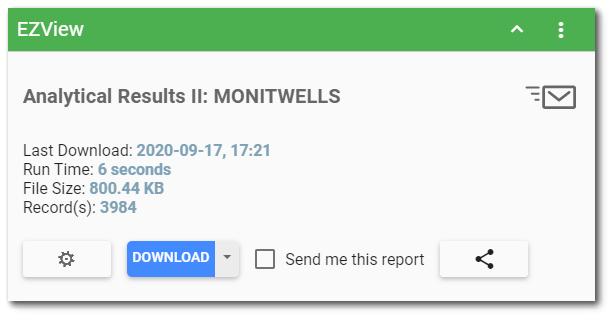
Note: Avoid placing this widget on the same dashboard as the Workflow widget. |
If EIA(s) are defined for the widget, an envelope icon is displayed in the upper right corner. Hover over the envelope icon to see how many EIAs are defined for the EZView widget.
The body of the widget displays the following if the Show Report Detail" setting is enabled:
Report Name – The name of the selected report.
Last Download – The date/time (end-user browser local time) that the report was last downloaded.
Run Time – The run time (i.e., elapsed time) indicates how long it took the report to run the last time it was downloaded (excludes download time).
File Size – The file size of the report output the last time it was downloaded.
Record(s) – If applicable, the number of records in the tabular output of the report the last time it was downloaded.
View/Edit Data
If the option to enable a link to the Report Parameter Editor is selected in the widget properties, the Edit ![]() icon will appear on the EZView widget to the left of the Download button. Clicking this icon opens the Report Parameter Editor in ad hoc mode, allowing a user to edit and download reports without saving an additional user report. Depending on the user's permission for the selected report, the user can do the following:
icon will appear on the EZView widget to the left of the Download button. Clicking this icon opens the Report Parameter Editor in ad hoc mode, allowing a user to edit and download reports without saving an additional user report. Depending on the user's permission for the selected report, the user can do the following:
•View/edit the report parameters.
•Run the report with the selected parameters.
•Save the report or create a new report.
Download or Send Data
Various file types are available for export, depending on the report type. The following are some common report file types:
•.xlsx – Microsoft Excel workbook containing the tabular data.
•.csv – Comma-separated, double-quote delimited text file containing the tabular data.
•.txt – Tab-separated text file containing the tabular data.
•.kmz – Google Earth kmz file containing Placemarks for each location and a balloon pop-up with the tabular data for that location.
•.shp – A .zip file containing the Esri Shapefile (locations as features) and other related files (*.dbf, *.prj, etc).
•.pdf – A Portable Document Format (PDF) file displaying the tabular data.
•.json – JavaScript Object Notation (JSON) for grid data (e.g. IGridReport).
Note: The PDF output is produced by generating default Report Definition Language (RDL) to display the table of data and rendering that RDL as .pdf file. For more information on customizing the default RDL used for displaying grid report data, see Default RDL Template. |
|---|
Download
1.To download report output with the default filetype, click the Download button.
2.If multiple filetypes are available for a report, select the filetype by clicking the drop-down arrow to download the report.
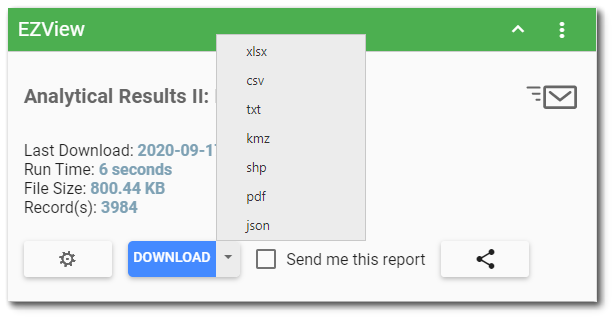
Send
1.To send the report directly (via email or via the Notice widget), click the Send me this report checkbox.
a.To send the report with the default filetype, click the Send button.
b.If multiple filetypes are available for a report, select the filetype by clicking the drop-down arrow to send the report.
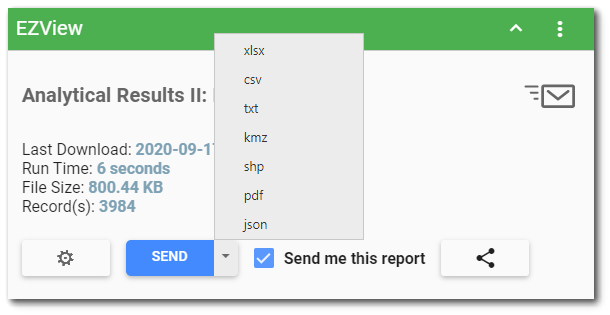
RDL Reports
A published RDL Report will show two download options:
•xlsx – The Microsoft Excel workbook produced by the published RDL as rendered by Microsoft's ReportViewer control.
•pdf – The PDF output produced by the published RDL as rendered by Microsoft's ReportViewer control.
For more information on RDL reports, see Designing RDL Reports and Publishing RDL Reports.
"Class" Reports
A non-grid report will only display the download option for the file type that it generates. For example, the "Google Earth: Locations" Report only generates *.kmz files, so only the .kmz option will be available. Thus, the Download button will not contain a drop-down menu.
Crosstab Reports
Crosstab reports can be downloaded from the EZView widget like any other report. See the Creating Excel Templates article for configuration details on crosstab templates.
Share Report
If the user has Viewer permission and a report is selected, the EZView widget displays a Share ![]() button. Share generates a link to the report for use in Microsoft Power BI or GeoJSON. The link includes a user token with a configurable expiration. Users can then share key EQuIS information with others via a URL. The recipient does not need to have EQuIS installed or a license to view the information. For the URL token to be valid, the following must be in place:
button. Share generates a link to the report for use in Microsoft Power BI or GeoJSON. The link includes a user token with a configurable expiration. Users can then share key EQuIS information with others via a URL. The recipient does not need to have EQuIS installed or a license to view the information. For the URL token to be valid, the following must be in place:
•Access to REST API licenses through the EQuIS database
•Deployment of a REST API License role to the EQuIS Enterprise site
•Assignment to the REST API role for the user creating the share URL
Note: The Share feature only works with user reports. It does not work with EIAs as a data source. |
|---|
Click the Share ![]() button to open the Share Report dialog window and generate the user token:
button to open the Share Report dialog window and generate the user token:
1.Use the calendar tool to select a Token Expiration Date, then select Microsoft Power BI or GeoJSON (for ArcGIS Online integration).
2.Click Create URL to open a dialog window displaying the token value.

3.Click the Copy button to automatically copy the token URL value to the clipboard and be available to share with others. The Close button will close the window.
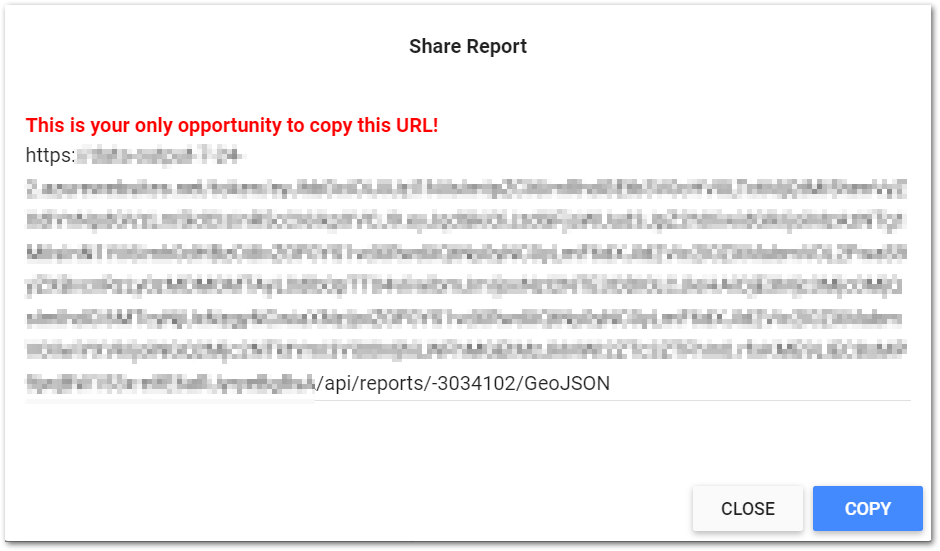
Warning: This is the only opportunity to copy the token URL value. After closing the Share Report window, the token value will not be accessible, and a new token will need to be created. |
GWSDAT Reports
For REST API users, a GWSDAT button is available in an EZView Widget with a Groundwater Spatiotemporal Data Analysis Tool (GWSDAT) report or user report loaded. The GWSDAT button only becomes available to REST API users after loading GWSDAT reports into the EZView Widget.
The button launches a new browser tab to load the report output directly into GWSDAT. The report provided to the tool is equivalent to output generated using the Share Report feature. Clients can elect to use the default online tool offered by GWSDAT.Net or provide an alternative self-hosted server by adding settings in ST.CONFIG, as detailed under EZView Widget Configuration Settings.
Warning: While the standard GWSDAT online tool will not store the data transmitted by API, self-hosting a version of the tool is recommended for confidential data. For information on deploying GWSDAT as an API, see the GWSDAT Github page. |
![]()
To learn more about the GWSDAT Report within EQuIS, see the GWSDAT Report page. For more information on GWSDAT, see the American Petroleum Institute's GWSDAT page.
Widget Properties
In the Widget Editor, EQuIS Enterprise users with Widget Editor permission can select a report, configure the report, and create EIAs. To add a report or edit other widget properties, open the Widget Editor by selecting More Options ![]() > Edit in the Widget Header.
> Edit in the Widget Header.
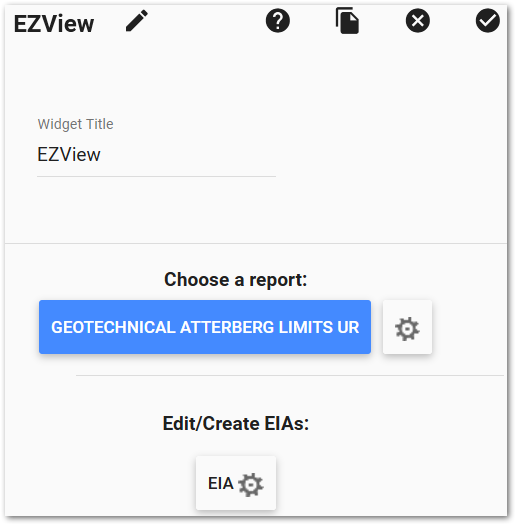
Options specific to the EZView Widget include the following:
Report Chooser – Select the report or EIA (as a data source) to be used with this instance of the EZView widget. The name of the currently selected report (if applicable) is displayed by default. To select a different report or EIA, click the Choose a Report button or name of the report. The Report Chooser will open and display available reports.
Report Parameter Editor – Click the Edit ![]() button to open the Report Parameter Editor for the selected report and edit the report parameters (e.g., analytes, date range, etc.). A user with Editor permission on the selected report may update the report.
button to open the Report Parameter Editor for the selected report and edit the report parameters (e.g., analytes, date range, etc.). A user with Editor permission on the selected report may update the report.
Edit/Create EIAs – Select the EIA ![]() button to create or edit an EIA. For a detailed discussion of EIAs, see the EQuIS Information Agents chapter.
button to create or edit an EIA. For a detailed discussion of EIAs, see the EQuIS Information Agents chapter.
View/edit parameters in the widget to run the report without saving – Check this option to add a button to the Report Parameter Editor ![]() for that report directly onto the EZView widget. Depending on the user's permission for the selected report, the user can view/edit the report parameters, run the report with the selected parameters, and save the report or create a new report.
for that report directly onto the EZView widget. Depending on the user's permission for the selected report, the user can view/edit the report parameters, run the report with the selected parameters, and save the report or create a new report.
Show Report Details – Check this option to hide/show the following report details on the widget: Last Download, Run Time, File Size, and Record(s).
For information on these general options, see the Widget Editor article:
•Widget Title •Widget Theme •Object Editor |
•Help •Copy Settings •Close without Saving |
•Save |